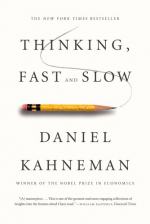
|
| Name: _________________________ | Period: ___________________ |
This test consists of 15 multiple choice questions and 5 short answer questions.
Multiple Choice Questions
1. Whose study on duration neglect and the peak-end rule involved a story of Jen, who died instantly in an automobile accident?
(a) Ed Dienter's.
(b) Christopher Hsee's.
(c) Baruch Fischhoff's.
(d) John Gottman's.
2. The author points out in Chapter 31 that professional golfers putt more successfully when doing what?
(a) Trying to achieve a birdie while ignoring the bogey.
(b) Avoiding a birdie rather than trying to achieve a bogey.
(c) Avoiding a bogey rather than trying to achieve a birdie.
(d) Trying to achieve a birdie while avoiding a bogey.
3. With what economist did Kahneman and Thaler work closely in Vancouver?
(a) Richard Thaler.
(b) Jack Knetsch.
(c) John Gottman.
(d) Bruno Frey.
4. In discussing vacations, the author presents the assertion that tourism is about what?
(a) Helping people erase memories of their home lives.
(b) Demonstrating commercialism for economic gain.
(c) Helping people construct stories and collect memories.
(d) Helping people create a world of fallacies.
5. In the following example from Chapter 30, the author posits the following in regards to a person choosing a marble from an urn. The red marbles win a prize. "Urn A contains 10 marbles, of which 1 is red. Urn B contains 100 marbles, of which 8 are red" (631). What are the chances of winning in Urn B?
(a) 8%.
(b) 10%.
(c) 16%.
(d) 20%.
6. Who is the author of Introduction to the Principles of Morals and Legislation?
(a) Jeremy Bentham.
(b) Shane Frederick.
(c) John List.
(d) Baruch Fischhoff.
7. Who is the author of The Halo Effect?
(a) Malcolm Gladwell.
(b) Baruch Fischhoff.
(c) Christopher Chabris.
(d) Philip Rosenzweig.
8. Who are the authors of Built to Last?
(a) Baruch Fischhoff and Gary Klein.
(b) Christopher Chabris and Daniel Simons.
(c) Jim Collins and Jerry I. Porras.
(d) Keith Stanovich and Richard West.
9. To whom is the following quote attributed: "The agent of economic theory is rational, selfish, and his tastes do not change" (525)?
(a) Richard Thaler.
(b) Gary Klein.
(c) Bruno Frey.
(d) John Gottman.
10. The author asserts that errors of prediction are inevitable for what reason?
(a) Because humans lack objectivity.
(b) Because we do not have the math to calculate the future.
(c) Because the world is unpredictable.
(d) Because humans lack statistical knowledge.
11. Who is the finance professor at U.C. Berkeley who created a study wherein he examined the trading records of 10,000 brokerage accounts of individual investors over a seven-year period?
(a) Baruch Fischhoff.
(b) Jim Collins.
(c) Terry Odean.
(d) Malcolm Gladwell.
12. The author states in Chapter 26, "In mixed gambles, where both a gain and a loss are possible," what happens (552)?
(a) "Confidence overrides logic."
(b) "Loss aversion causes extremely risk-averse choices."
(c) "Loss aversion causes narrative fallacies."
(d) "Risk seeking behavior causes extremely loss aversive choices."
13. The author states in the opening of Chapter 29, "Whenever you form a global evaluation of a complex object--a car you may buy, your son-in-law, or an uncertain situation--you" do what (600)?
(a) "Assign weights to its characteristics."
(b) "Make immediate assumptions."
(c) "Evaluate the normalcy of the events or subjects."
(d) "Seek advice from experience."
14. How are decision weights and probabilities regarded in prospect theory?
(a) Variations of probability have less effect on decision weights.
(b) Weights are more important.
(c) The same.
(d) Probabilities are more important.
15. Who wrote the 2005 book Expert Political Judgment: How Good Is It? How Can We Know?
(a) Baruch Fischhoff.
(b) Philip Tetlock.
(c) Malcolm Gladwell.
(d) Jim Collins and Jerry I. Porras.
Short Answer Questions
1. What dean of the University of Chicago Graduate School of Business was a firm believer in standard economic theory?
2. Who proved mathematically that attempts to explain loss aversion by the utility of wealth are doomed to fail?
3. What term introduced by Nassim Taleb describes how flawed stories of the past shape our views of the present and the future?
4. In Chapter 31, the author posits that the main motivators of money-seeking individuals (aside for the very poor) are what?
5. The author notes in Chapter 36 that "Caring for people often takes the form of concern for the quality of their stories, not for" what (744)?
|
This section contains 656 words (approx. 3 pages at 300 words per page) |

|




